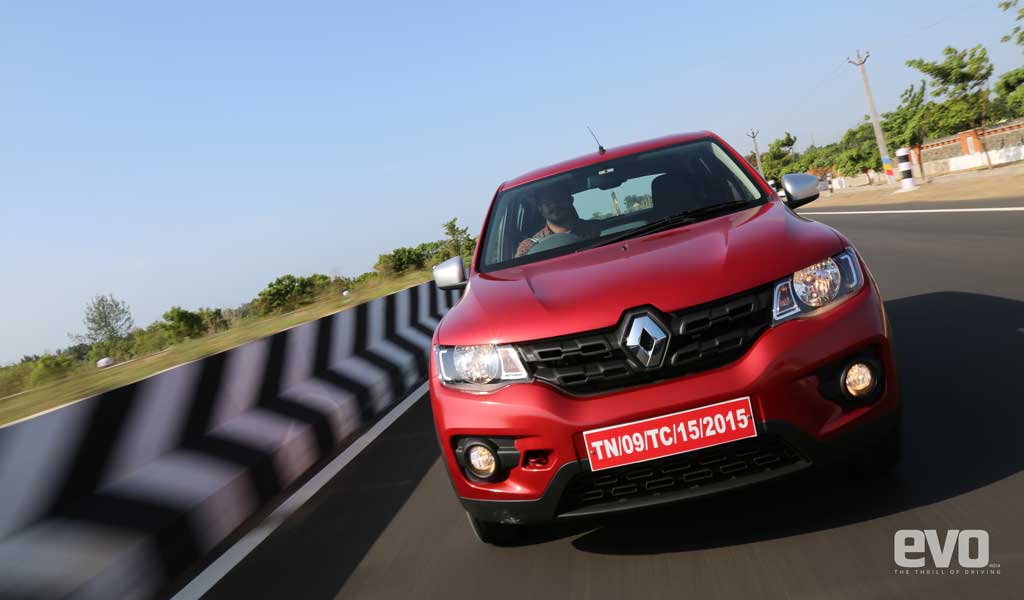Renault Kwid 1-litre review

Bigger engine, more power, better acceleration, this is what the new Renault Kwid 1-litre is all about. Back in 2015 when the Kwid first hit Indian roads, it created quite the stir, with a promise to change the perspective of the small car segment. And in this one year around 80,000 Kwids have hit Indian roads.
Sure Maruti Suzuki are way ahead in the number game and presence across the country with the Alto and Hyundai have everything in place with the Eon, but Renault has made its presence felt in the segment, grabbing a decent market share in the small car segment with the Kwid. And with the launch of the Kwid 1-litre, the company aims to further strengthen their stronghold in the small car segment.
Stands out
What really gets people to walk into showrooms, is the Kwid’s bold SUV styling cues – high bonnet, aggressive looking front bumper, squared off wheel arches and plastic cladding, all of which gives it a lot more presence on the road when compared to the other cars in the segment. From the outside the new Kwid looks similar to its sibling, what differentiates the two is the racing decals sporting the 1-litre badging on the side skirts and the silver finished wing mirrors. The only letdown are the tiny 155/80R13 tyres that leave huge gaps in the wheel arches. But nevertheless, Renault is offering customers a choice of 25 decals along with 6 customisation packages which adds brownie points to the Kwid’s style. There is a chrome package which offers plenty of faux-chrome exterior highlights that will appeal to the general Indian psyche.
Customers sometimes tend to ignore the certain aspects of a car like the power output or top speed and are more focused on what extra the car has to offer. This is where the Kwid sets the benchmark in the small car segment. Following in the footsteps of its predecessor, the new Kwid gets the same – a touch screen infotainment system (as seen in the Duster), satellite navigation, USB, an aux-in port and Bluetooth connectivity.
Power
An additional 14bhp and 19Nm of torque is what really the 1-litre Kwid’s USP. The new 999cc, three-cylinder engine makes 67bhp at 5,500rpm and 91Nm at 4,250rpm which now equals the Alto K10, but is two bhp short of the Eon. Since it tips the scales at just 699kg (39kg heavier than the 0.8L Kwid), it has a weight advantage over its competitors with a class leading power to weight ratio of 95.6bhp/tonne. This sure makes the new Kwid a lot peppier to drive.
The new 1-litre engine sure is responsive, but feels a bit jerky when you are inching your way in traffic. What is good though is that the torque kicks in really early and there is enough power to pull away without a fuss. The 0.8-litre engine did have a flat spot in its power delivery, but the added 14bhp solves that problem. The five-speed manual transmission shifts smoothly, though when you really rev it to its limit, the Kwid sounds thrashy at high revs. It is best to short shift it to keep the three-cylinder motor happy. Renault isn’t chasing any record efficiency figures with the 1-litre Kwid like it did with the 0.8 Kwid but even with this higher output, it comes with an ARAI claimed 23.01kmpl fuel efficiency figure.

Renault is known for its well-tuned suspension setup, be it the Duster or the Fluence, and the Kwid got the same DNA as well. Since the suspension setup remains the same, the 1-litre rides well too. With the added engine power and torque, the Kwid is stable at high speeds, pretty much holds on to its line when you push it through corners – despite the small tyres and tackles the bad surfaces equally well. For a budget car, the Kwid’s ride is very impressive. The Kwid uses the same tyres and brakes, so with the added performance, you feel the need for more bite. Especially because the buyers of the 1-litre will be those who are looking for a nippier hatchback than what the 0.8-litre Kwid offers.
Smaller yet bigger
There is no change in the size and shape of the car in any way so the excellent 180mm ground clearance carries forward and there is 300-litre boot space too (1,115 litres with the rear seat folded). The seats get a new multi-colour scheme in the 1-litre Kwid to differentiate the two variants. Why the Kwid has been such a hit is because the space and the driving comfort can be enjoyed by six-footers as well, and even with the driver’s seat all the way back with a tall guy like me behind the wheel, there is enough space in the rear to keep your feet in one piece.

The competition in the small car segment is pretty much cut-throat and sometimes one worries with every manufacturer trying to outdo the other, a lot of corners are cut, especially safety. In pursuit for an aggressive price tag, safety features are given a miss and same goes with the Kwid. It gets just one driver side airbag, and there is no ABS even as an option. What is new and a first-in class is the Pro-Sence seatbelt technology. Not much has been revealed about this technology, so we shall wait for the launch and more details to surface soon.
Expect the Kwid 1-litre to be priced at a Rs 30,000-40,000 premium over the 0.8-litre Kwid which means it will continue to be an excellent value proposition. The company also plan to launch the AMT version of the Kwid before the end of the year. The Kwid is well established now and is going from strength to strength with the introduction of new variants. This 1-litre Kwid sure is a challenging product to the Alto K10 and the Eon 1.0.


